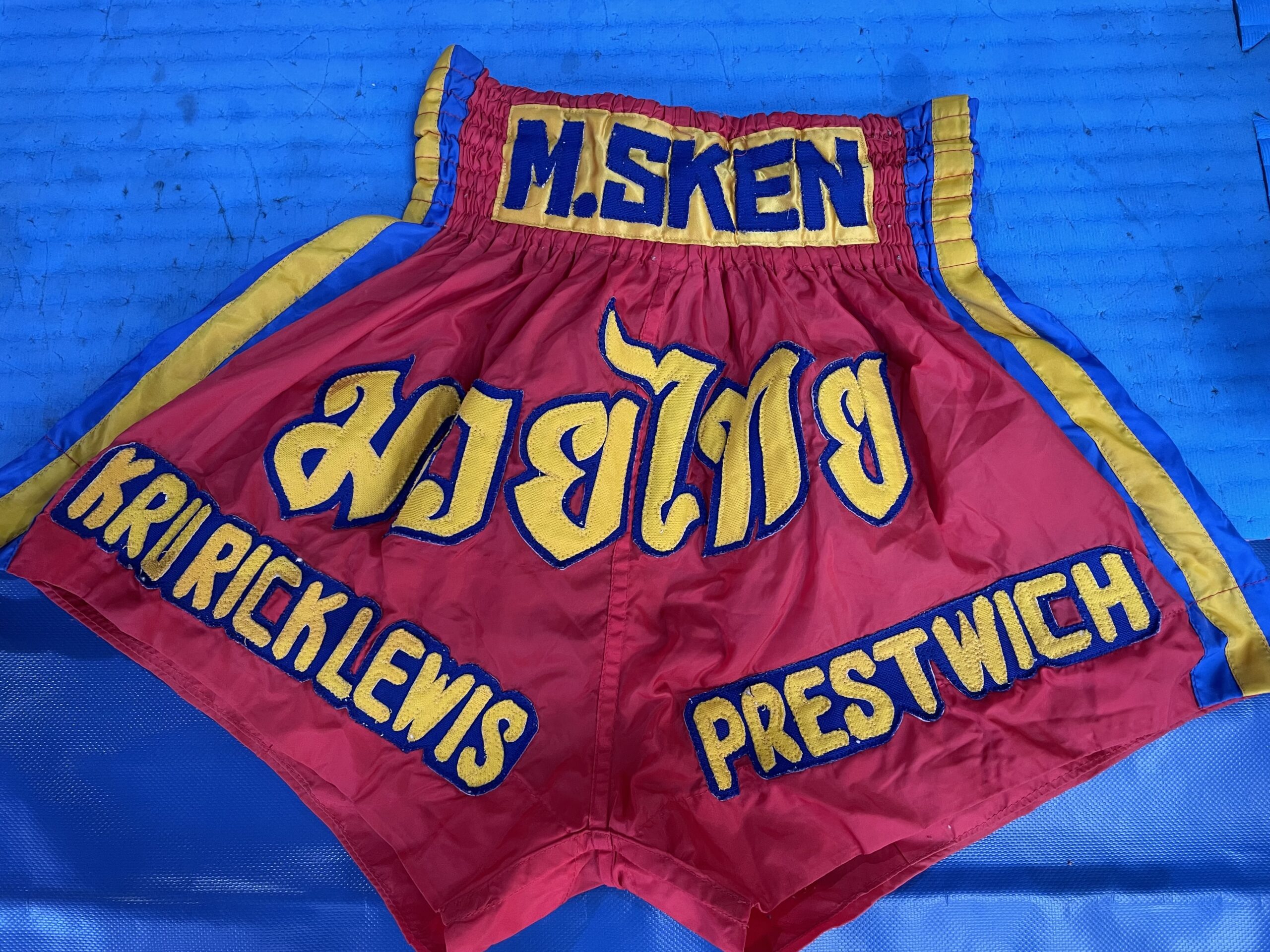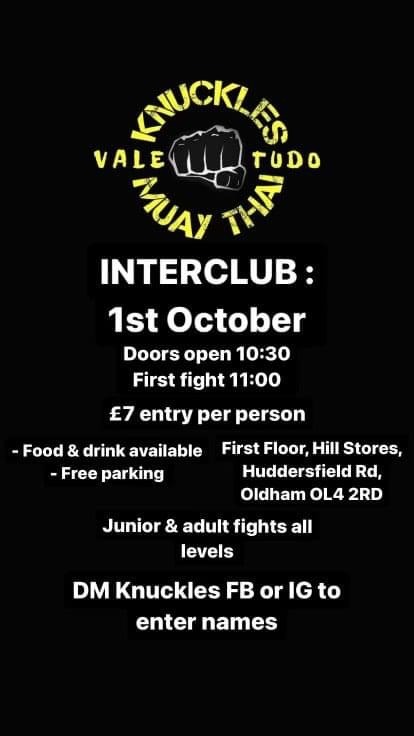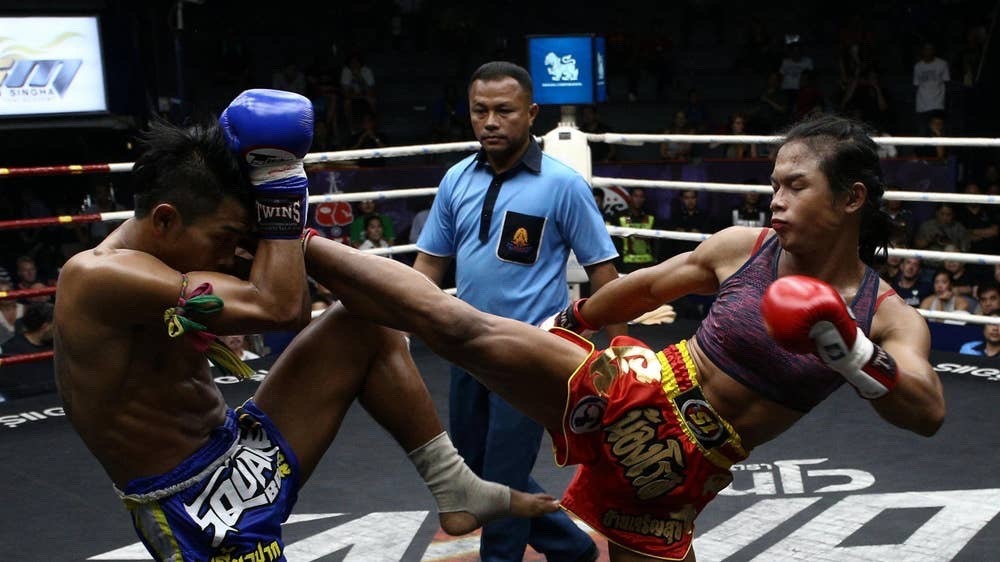




Knuckles Muay Thai
INTERCLUB:
1st October
Doors open 10:30
First fight 11:00
£7 entry per person
Junior & adult fights all levels

SUNDAY 6TH MARCH
Altrincham Sootball Club, Vloss
Lane, Altrincham. WAL5 SAJ
KIDS AND ADULTS £7 EACH. DOORS OPEN AT
10:30AM, FIGHTS START AT 11AM

Thailand is widely seen as a paradise for LGBT people, but many say they are treated as second-class citizens
Credit to the independent
Friday 4 August 2017 16:46
Clad in a pink tank top and shorts, her face made up with rouge and red lipstick, Nong Rose Baan Charoensuk, a transgender Muay Thai fighter, is a formidable opponent.
Just ask Karun “Priewpak” Kaemlam, a male fighter who lost a thrilling five-round match to Rose, as she is generally known, last month.
“I wasn’t able to fight her strength and big build,” Priewpak says.
“She fights like a man because she is really a man,” adds Priewpak, who suffered a gash above his right eye in the fight at Rajadamnern Stadium in the Thai capital.
It was the second consecutive win for Rose in the revered Muay Thai arena after becoming the first transgender boxer to fight there in June.
The crowd was clearly in her corner, cheering wildly for her throughout.
“Being a transgender doesn’t mean that we’re weak,” Rose says. “We can achieve anything as well.”
The 21-year-old started boxing at eight, following in the footsteps of an uncle, a Muay Thai fighter who encouraged her to train. Her twin brother also takes part in the sport.
Born Somros Polchareon, Rose says she identified as a woman at an early age and began wearing make-up and a sports bra in the ring.
In the rural towns where she has done most of her fighting, her appearance has disconcerted some of her male opponents.
“They would say they didn’t want to fight with a gay person, as it would be embarrassing if they won or lost,” she says.
“I still face those insults, but I don’t care about them.”
Shape Created with Sketch. Five rounds with Bangkok’s trans boxing superstar
left Created with Sketch. right Created with Sketch.
Thailand is widely seen as a paradise for gay and transgender people, but many say they are treated as second-class citizens.
Transgender women figure on television, in beauty pageants and at hair salons and cosmetics counters, but they cannot change their gender on identity papers, despite a 2015 law against gender-based discrimination.
Independent news email
After more than 300 fights, racking up 30 of her 150 wins through knockouts, Rose says she was finally allowed to fight at Rajadamnern Stadium.
Puttipong Plukram, the owner of the camp in the province of Buriram where Rose trains, calls her a “great role model”, citing her diligence in chores and training.
“Everyone respects and adores her,” says Puttipong.
Rose is not Thailand’s first transgender boxer. That was Parinya “Nong Toom” Charoenphol, the subject of the 2004 film Beautiful Boxer. Toom eventually ran a boxing school and Rose hopes to do the same one day.
Rose also aspires to be an ambassador for Muay Thai around the world, and urges transgender boxers in rural areas not to be discouraged by early setbacks.
“They have to fall first and overcome that, then the finish line won’t be far out of reach.”
Reuters
Show all 14
By Corey Erdman Published On Mon Jul 13, 2020, 02:01 AM EST https://www.boxingscene.com
If you were to see Sangarthit Looksaikongdin in the ring without any background or context, you wouldn’t guess that he was 16 years old.
Or that he had turned pro at 14 years of age.
Sangarthit was in action on Saturday at The Bazaar Hotel in Bankok, Thailand on Saturday, as he defeated Kulabdam Sor Jor Piekuthai for the WBC Asia light welterweight title. To the casual observer, the bout did not look like a 16-year old fighting a 21-year old Muay Thai convert. Sangarthit was composed well beyond his years, boxing off the back foot and running his southpaw opponent into both lead and counter right hands round after round. The teenager did eat some heavy shots, particularly a flush left hand in the third round, but managed to temper Kulabdam’s fiery aggression particularly in the later stages. Scores were 97-94, 95-94 and 99-92 in favor of Sangarthit.
Outside of the ring, Sangarthit (born Phoobadin Yoohanngoh) is exactly the way you would envision a 16-year old being. His social media is impeccably curated, with well-staged influencer-esque photos and brief captions. He’s dressed in Supreme and accessorized with new jewelry from a local sponsor as he live streams his trip through the mall after his fight to buy a new pair of Adidas Boosts. In an interview posted by his promoter, TL Boxing Promotion, he reveals that he’d like to become a YouTuber as well as a boxer.
Where he would find the time to do that, or where he finds time to take part in normal teenager activity is uncertain. Over the past year, Sangarthit has managed to win the WBC Asia title at 140 pounds, win The Fighter tournament put on in Thailand, and also won the Hilux Revo Marathon in his weight class as a Muay Thai fighter.
Born into a fighting family, he is reportedly the 14th child out of 16 siblings. When he trains at the family gym, an outdoor hut in Bangkok, he is constantly surrounded by children. Sangarthit is young enough to technically be in the same school as many of them, but his life has a drastically different focus. His father and brother train him, and his fellow fighting siblings look on and loiter on the ring apron. Those siblings include women’s minimumweight contender Duangdawnoi Looksaikongdin (born Kanyarat Yoohanngoh), who was also 14 when she made her professional debut in 2014 according to BoxRec.
These stories of teenagers, children in some cases, turning professional are not unprecedented in boxing, but they are most certainly rare. In 1923, Nipper Pat Daly turned pro at the age of 10 (some accounts listed him as being nine), and by September of 1929, was ranked No. 10 by Ring Magazine at bantamweight, by far the most stunning achievement of a child professional boxer ever.
Eventually, rules would be set in place in most countries to prevent such things from happening. One doesn’t have to think hard to figure out why professionally boxing adults would be dangerous for children and teenagers, and how easily it could turn into exploitation, if it wasn’t from the outset.
Mexico still allows fighters under the age of 18—Canelo Alvarez turned pro at 15, and quite often prospects looking to turn pro early pick up early wins in Mexico. In the United States, select states will allow fighters under the age of 18 with significant amateur achievements to box professionally pending parental approval, as was the case with Tristan Kalkreuth for his 2019 bouts on DAZN. On the same day as Sangarthit-Kulabdam, 16-year old super featherweight Yoo Chan Lee had his second pro bout in South Korea as well.
But the phenomenon of teenage boxers is much more prevalent in Thailand than anywhere else.
“There’s often been a feeling that Thailand is the “wild west” of Asian boxing, allowing not just super young kids to turn professional but also allowing world champions to fight stay busy bouts against absolute novices and over-matched opponents,” said Scott Graveson, founder of the indispensable Asianboxing.info, the best chronicle of the Asian boxing scene for English speakers.
“For some fighters it’s handled safely. They don’t tend to throw the kids in super tough, but overall the safety does look really lax at a lot of Thai shows. Thankfully there does seem to be a growing level of care in how shows are handled. TL Promotions and the WP Boxing shows have higher production standards than what we were accustomed to in Thailand for years. There is, of course, a few bouts that look very out of place, but by and large they are prodigies against novices. I suspect in the US some of the sparring for teenagers are tougher than some of the early bouts for the Thai teens.”
With regards to Sangarthit, the question is whether the minor title he now holds is merely symbolic or a sign that his brain trust has intentions of maneuvering him into riskier, more challenging fights. While he defeated Kulabdam conclusively, good portions of the fight were fought on relatively even terms, and his opponent in this case was a 2-1 duel sport fighter who had never gone past the third round as a boxer. Nonetheless, the minor belt he captured could theoretically see him enter the WBC’s Top 40 at light welterweight and put him in the neighborhood as far more developed fighters such as Shohjahon Ergashev (most recently ranked 33rd) or former titleholder Argenis Mendez (31st). Educated observers understand that these belts and rankings have little meaning, but their value still exists for promoters and matchmakers who need to play ball with sanctioning bodies. As impressive as he may look, it would be unwise to pay attention to those rankings and maneuver Sangarthit like a regular 9-0 prospect and not like a 16-year old.
“I’m not sure he’ll ever be a global star, but he does tick a lot of boxes to be a notable figure. He’s young, has a great back story, looks very mature for a teenager, has a good boxing brain on his shoulders, can box going forwards or backwards. The issue is going to be his development over the next 2 or 3 years. He’s going to have to be matched well to develop his skills, and I’m not sure if TL Promotions and Thairath have the financial clout to get him either the bouts he needs or the sparring,” said Graveson. “In saying that if they have the money and spend that on getting him experience stateside, getting him training in the US with some American and Mexican fighters at the weight, there’s no reason why he can’t become a star. I think naturally he’s a fighter with a higher ceiling than Teerachai Kratingdaenggym (Kiram Tewa) who fought for a world title at a similar weight, but we’ll have to wait a long time to see him reach that ceiling. The potential is there, but it’s how his team handle and nurture that potential that is going to be the tricky thing.”
courteous of The Muay Thai Guy Sean Fagan
No matter how long or short you’ve been practicing Muay Thai, it’s always good to look over some general etiquette so the gym is a comfortable place for everyone.
1. Show up on time. Better yet, show up 10-15 min early.
One of the best quotes when it comes to punctuality came from the movie Drumline:
“If you’re on time you’re late, if you’re early you’re on time.”
Get off to a good start by showing your trainers that you’re game and ready to learn; the first step to doing this is respecting the class start and end times. Show up early to change, wrap your hands, and other things you may need to do before taking a class.
2. No shoes on the mat.
This goes for most martial arts, not just Muay Thai. Stepping on the mat with your shoes brings in all the dirty stuff from outside and can include diseases like staph.
3. Have and bring your own gear.
If you’re just starting out, it’s understandable that you need some time before ordering your first pair of gloves.
But if you’ve been training for more than a few weeks and plan to continue, you’re gonna need to have your own set of gear. This includes gloves, handwraps, shinguards, and shorts. Don’t expect your gym to have any on loan (it’s not sanitary anyway). If you consistently forget your gear, make a mental checklist before you leave the house. And don’t forget to bring your gear home!
4. Wash/air out/sanitise your gear!
There is almost nothing worse than having someone at the gym who smells bad! Avoid awkward conversations and confrontations by taking a bit of time to take the gear out of your bag when you get home from training so you can air out your gloves and shinguards.
Shorts and handwraps need to be washed just like your everyday clothes. You can invest in some deodoriser/sanitising spray for your gear, but airing your gear out usually does the trick (no moisture = no bacteria growth = no smell).
5. Other basic hygiene…
Cut your nails short so you don’t scratch people during clinching. This includes your toenails because people have been cut by long toenails and that’s just disgusting. Wear deodorant. Don’t wear a lot of cologne or perfume. Wash your clothes. Tie your hair back if it’s long. Use a towel or bring an extra shirt if you sweat more than other people. Don’t train when you’re sick so you don’t get others sick.
6. Wear compression underwear!
Under your thai shorts if you’re male and compression shorts if you’re female.Thai shorts generally have bigger leg openings so the wearer can kick more comfortably. Let’s not flash our private parts to everyone by wearing proper undergarments. We’re here to train, not get grossed out.
Also, as a side note to dudes, everyone can see your junk through your sweaty shorts if you don’t wear at least boxer briefs. This makes some people not wanna clinch with you ‘cause if you can see it, you can definitely feel it.
7. Shut up when the trainers are talking.
This is common sense. You know you shouldn’t be talking during school while your teachers are, and this is no different. When the trainers are giving group feedback or showing a new technique, be quiet so people (including yourself) and listen and see what’s going on. To learn, you have to open your eyes and ears before opening your mouth
8. Do what you’re told.
Okay, so, it might not be good general life advice to blindly do things, but let’s break down a few things that make this different in Muay Thai. You’re paying for lessons at a gym you like being at, so you know the trainers there know more than you do. Whether you’re there to learn new skills or just get in better shape, you trust the trainers there to do what brings you closer to your goal…otherwise you wouldn’t be there.
That being said, if you’re told to do 50 kicks or 100 situps, don’t make faces. Don’t complain. Don’t run to text people every other round. You don’t get more energy from making faces. You don’t get results from complaining. Just do it and let your progress speak for itself. And leave the phone alone until after class is done.
9. Don’t spar at 100%
(unless you already made sure your sparring partner is ok with it).
Wear big gloves for sparring. This has to be said a lot, unfortunately. If we’re on the same team, there’s no reason why we need to train in a way that will hurt each other. Save that type of for a fight. It’s okay to spar aggressively and catch your partner with shots, but do it in a controlled manner.
Technical sparring is key (see below for some drills) and will get you much further (and less injured) than hard sparring will. Spar with 14oz and higher.
Also, know when to adjust your power against smaller people whose maximum power outputs are much less than yours. Light sparring against someone your size might feel very different to someone who’s 20 kg lighter than you. People are also under the impression that when they spar a fighter that they are going into a brawl.
Experienced fighters are the most controlled people you will ever spar with, so there is no need to throw a series of 20 combinations in a matter of seconds.
10. Clinch hard, knee softly.
The same goes for clinching as it does for sparring, especially since muscling won’t get you anywhere in clinching as you further your training. It’s perfectly fine to use your upper body power as you’re not hurting anyone with it – just be controlled and stop cranking their neck when you already have their head down. Knees can slap but should not be hard.
When clinching, you’re probably not wearing any gear to cover your knees, and knee shots hurt! Use mostly the inside thigh near your knee to strike, and if you ever use the knee cap, go very lightly.
11. Wash your hands before clinching.
Ever smell your hands after taking them out of your gloves? Yeah.
12. Respect everyone.
This includes your trainers and training mates. You can always learn something from anyone, no matter what their level is. They’re on the journey with you.
13. Have realistic expectations.
This is a big umbrella that houses many, many mistakes people make. Don’t expect to do a lot of flashy spinny moves on your first day (if you want purely flashy and spinny stuff, maybe Muay Thai isn’t the sport for you).
Don’t think just because you’ve been in a few street fights that you can just jump into sparring… and don’t expect to be “good at Muay Thai” just because of those street fights. Above all, remember it takes time and consistency to progress. I’ve met a lot of people who were super down on themselves for still being “not good” their first month. Keep going and don’t give up.